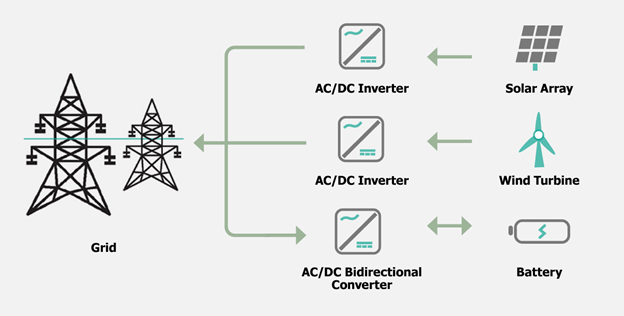The ERO Enterprise (NERC and the six Regional Entities collectively) Inverter-Based Resource (IBR) Registration Initiative has been well underway for almost 12 months. The purpose of this initiative is to close an identified reliability gap with IBRs connected to the bulk power system (BPS) that have a material impact on the BPS but are unregistered and therefore not subject to NERC Reliability Standards.
About Inverter-Based Resources
An inverter is a power electronic device that converts direct current (dc) electricity to alternating current (ac) electricity.

(source: https://www.nerc.com/pa/Documents/2023_NERC_Guide_Inverter-Based-Resources.pdf)
The ERO Enterprise uses the term “inverter-based resource” to refer generally to BPS-connected facilities that have a power electronic interface between the ac grid and the source of electricity. Inverter-based resources include modern wind turbines, meaning type 3 and type 4 wind turbines, solar photovoltaic, and battery energy storage resources, as well as high voltage direct current circuits and flexible alternating current transmission system devices like static synchronous compensators and static volt-ampere reactive compensators.
IBRs have transformed the grid and have become a key contributor to BPS reliability over the years. IBRs have very different operating characteristics than synchronous generation resources (coal, gas, and nuclear plants), which have been in operation for several decades. Both inverter-based resources and synchronous generators are capable of providing essential reliability services to the BPS. However, the industry is facing challenges integrating significant levels of inverter-based resources because of the unique differences between technologies. Inverters are still relatively new resources and can introduce risks to grid stability with improper settings. NERC began analyzing a five-year period of data in 2021 that focused on BPS resource reliability trends. The risk that IBRs pose to reliable operation of the BPS was identified as an area of focus because many of these resource fall under the power threshold that requires registration and federal oversight of the owners and operators of these bulk power system-connected resources.
The Federal Energy Regulatory Commission (FERC) issued Order RD22-4-000 in November of 2022 directing NERC to address a wide spectrum of reliability risks to the BPS from the application of inverter-based technology, including requirements for IBRs that are owned or operated by existing registered entities, as well as by those that are operated by entities not currently registered with NERC. NERC filed the requested work plan in February 2023, which was accepted by FERC on May 18, 2023 in Order RD22-4-001.
The NERC Work Plan revealed a 16 percent reliability gap with BPS-connected IBRs that are not subject to NERC Reliability Standards and that trend is expected to continue. The NERC Work Plan also identifies milestones to implement the FERC-directed Order in three phases over three years:
- Phase one: May 2023–May 2024: Complete Rules of Procedure (ROP) revisions
- Phase two: May 2024–May 2025: Identify candidates for registration
- Phase three: May 2025–May 2026: Register candidates
The first step in the process is to revise the NERC Rules of Procedure (ROP), specifically: Appendix 2 – Definitions; Appendix 5A – Organization Registration and Certification Manual; and Appendix 5B – Statement of Compliance Registry Criteria. The NERC Board of Trustees approved these ROP revisions on February 22, 2024. The proposed revisions are awaiting FERC approval, which will mark the completion of phase one.
The ERO Enterprise has already begun identifying potential registration candidates based on Energy Information Administration (EIA) 860 data, the NERC Compliance Registry (NCR), and information gathered from industry stakeholders. NERC and the regions plan to focus more on specific outreach and education during the second phase of the work plan implementation to ensure unregistered entities are aware of the new criteria.
The new Category 2 Generator Owner or Generator Operator registration criteria will apply to owners and/or operators of IBRs with an aggregate nameplate capacity equal or greater than 20 megavolt-amperes or MVA (MVA is the rating of the generator based on the total power which combines real power with reactive power, using this rating ensures the generator is sized appropriately for the transmission system where it is interconnecting) at an interconnection point of 60 kilovolts (kV) or greater and that is material to the reliable operation of the interconnected BPS.
The ERO Enterprise is providing quarterly updates to industry stakeholders as this important initiative progresses. Questions related to this initiative should be directed to [email protected].
Bryan Clark, PE, MRO Director of Reliability Analysis